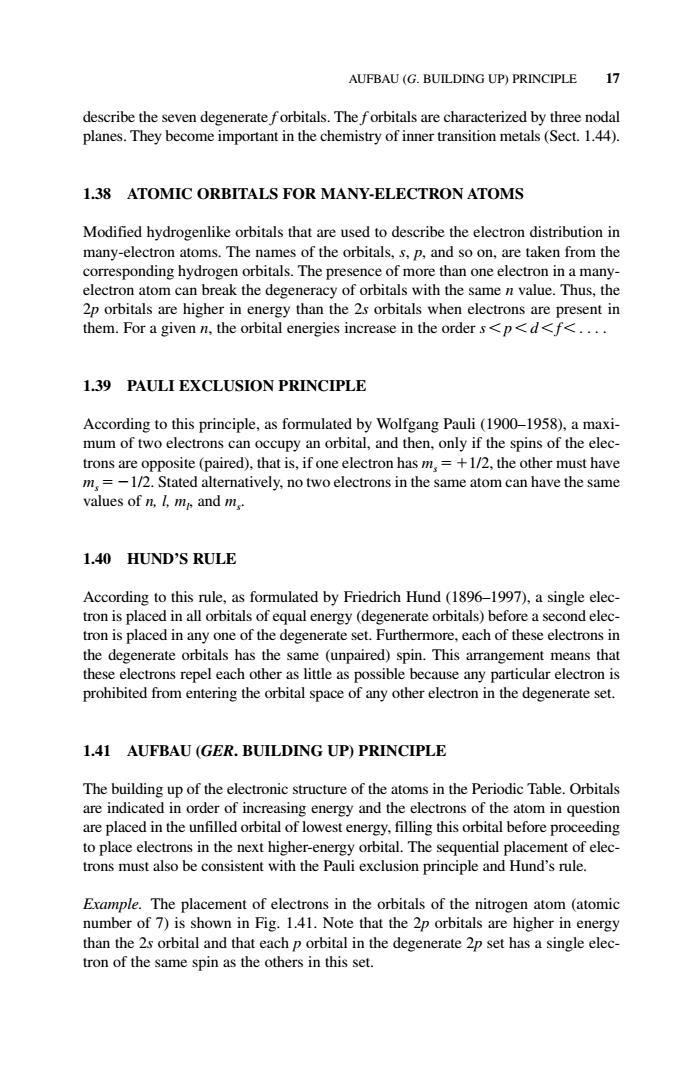正在加载图片...

AUFBAU (G.BUILDING UP)PRINCIPLE 17 escribe the seven degenerate forbitals.The forbitals are characterized by thre nodal planes.They the chemistry metals (Sect1.4). 1.38 ATOMIC ORBITALS FOR MANY-ELECTRON ATOMS Modified hydrogenlike orbitals that are used to describe the electron distribution in many-electron atoms.The names of the orbitals.s.p.and so on,are taken from the rresponding hydro ce of n hanoneelectonin atom can br ebiasTepwOobia ak the degenerac with t 2p orbitals are higher in energy than he same n value.Thus,the when electrons are present in them.For a given n,the orbital energies increase in the order s<p<d<f<.... 1.39 PAULI EXCLUSION PRINCIPLE According to this principle,as formulated by Wolfgang Pauli (1900-1958),a maxi an orbital,and then,only if the spins of the elec. paired).th her m ust have Stated alternatively,no two electrons in the same atom can have the same values of n.l,m and m. 1.40 HUND'S RULE According to this rule.as formulated by Friedrich Hund(1896-1997).a single elec- enerate orbitals)bef of the degenerae set.Furthemore.cach of theec equal energy( the degenerate orbitals has the same (unpaired)spin.This arrangement means that these electrons repel each other as little as possible because any particular electron is prohibited from entering the orbital space of any other electron in the degenerate set. 1.41 AUFBAU (GER.BUILDING UP)PRINCIPLE s in the Periodic Table.Orbitals n orde of increa sing energy and the ons of the atom in question are placed in the unfilled orbital of lowest energy,filling this orbital before proceeding to place electrons in the next higher-energy orbital.The sequential placement of elec- trons must also be consistent with the Pauli exclusion principle and Hund's rule. Erample.The placement of electrons in the orbitals of the nitrogen atom (atomic number of 7)is shown in Fig.1.41.Note that the 2p orbitals are higher in energy chp orital in the degenerate 2p set hasa single eedescribe the seven degenerate f orbitals. The f orbitals are characterized by three nodal planes. They become important in the chemistry of inner transition metals (Sect. 1.44). 1.38 ATOMIC ORBITALS FOR MANY-ELECTRON ATOMS Modified hydrogenlike orbitals that are used to describe the electron distribution in many-electron atoms. The names of the orbitals, s, p, and so on, are taken from the corresponding hydrogen orbitals. The presence of more than one electron in a manyelectron atom can break the degeneracy of orbitals with the same n value. Thus, the 2p orbitals are higher in energy than the 2s orbitals when electrons are present in them. For a given n, the orbital energies increase in the order s p d f .... 1.39 PAULI EXCLUSION PRINCIPLE According to this principle, as formulated by Wolfgang Pauli (1900–1958), a maximum of two electrons can occupy an orbital, and then, only if the spins of the electrons are opposite (paired), that is, if one electron has ms 1/2, the other must have ms 1/2. Stated alternatively, no two electrons in the same atom can have the same values of n, l, ml , and ms. 1.40 HUND’S RULE According to this rule, as formulated by Friedrich Hund (1896–1997), a single electron is placed in all orbitals of equal energy (degenerate orbitals) before a second electron is placed in any one of the degenerate set. Furthermore, each of these electrons in the degenerate orbitals has the same (unpaired) spin. This arrangement means that these electrons repel each other as little as possible because any particular electron is prohibited from entering the orbital space of any other electron in the degenerate set. 1.41 AUFBAU (GER. BUILDING UP) PRINCIPLE The building up of the electronic structure of the atoms in the Periodic Table. Orbitals are indicated in order of increasing energy and the electrons of the atom in question are placed in the unfilled orbital of lowest energy, filling this orbital before proceeding to place electrons in the next higher-energy orbital. The sequential placement of electrons must also be consistent with the Pauli exclusion principle and Hund’s rule. Example. The placement of electrons in the orbitals of the nitrogen atom (atomic number of 7) is shown in Fig. 1.41. Note that the 2p orbitals are higher in energy than the 2s orbital and that each p orbital in the degenerate 2p set has a single electron of the same spin as the others in this set. AUFBAU (G. BUILDING UP) PRINCIPLE 17 c01.qxd 5/17/2005 5:12 PM Page 17�